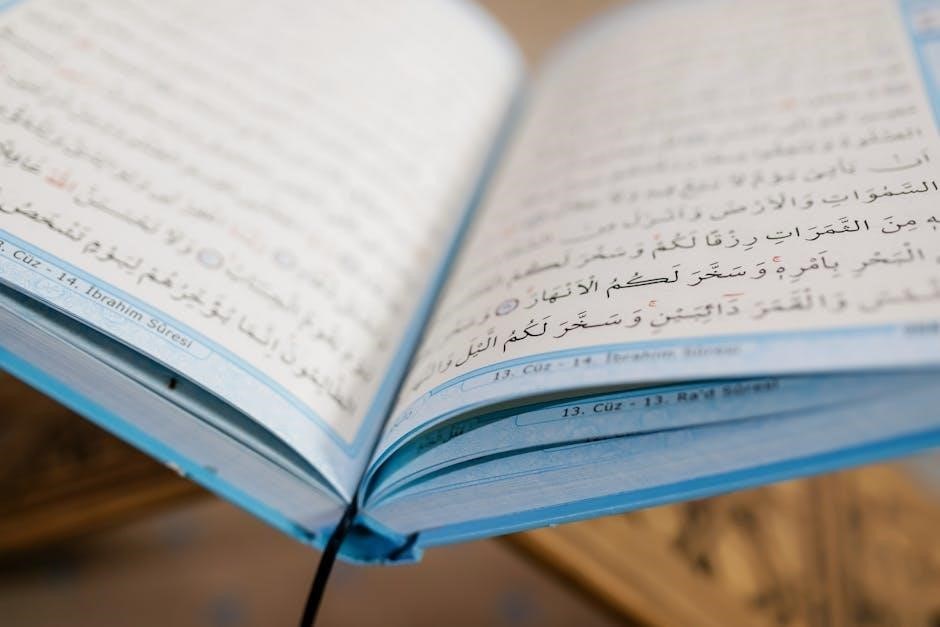
The Book of Revelation is the final book of the New Testament, written in the apocalyptic genre, filled with symbols and signs to convey spiritual truths.

Importance of Interpreting Symbols
Interpreting symbols in the Book of Revelation is crucial for understanding its spiritual truths and divine messages. The apocalyptic genre relies heavily on imagery and metaphors, requiring careful analysis to avoid misinterpretation. Symbols like the Lamb, Dragon, and New Jerusalem convey profound meanings tied to themes of judgment, redemption, and God’s ultimate triumph. Misunderstanding these symbols can lead to confusion about the book’s message. By studying biblical context and references, readers can uncover deeper insights, ensuring interpretations align with the text’s intended purpose. Proper interpretation allows believers to grasp the book’s prophetic significance and its relevance to faith and history, avoiding personal biases and ensuring a more accurate understanding of God’s plan.

Common Symbols and Their Meanings
The Book of Revelation contains a rich array of symbols, each serving unique roles in conveying divine truths, judgment, and ultimate redemption through intricate imagery and metaphors.
3;1 Numbers
Numbers in the Book of Revelation carry profound symbolic meanings, often tied to divine completeness, judgment, or spiritual significance. The number 7, for instance, represents perfection and completeness, as seen in the seven churches, seals, trumpets, and bowls of wrath. The number 3 symbolizes divine completeness, reflected in the Trinity and phrases like “holy, holy, holy.” The number 12 signifies completeness in God’s plan, such as the 12 tribes of Israel and the 12 apostles. Conversely, the number 666, known as the “mark of the beast,” represents evil and rebellion against God. The number 144,000 symbolizes the redeemed from each of Israel’s tribes, representing God’s ultimate salvation plan. These numerical symbols are central to understanding Revelation’s deeper spiritual truths and prophetic messages.
3.1.1 Number 7
The number 7 is one of the most prominent symbols in the Book of Revelation, representing completeness, perfection, and divine fulfillment. It appears repeatedly in various forms, such as the seven churches, seven seals, seven trumpets, and seven bowls of wrath. These instances emphasize God’s sovereignty and the completion of His judgment and redemption plans. The number 7 also symbolizes spiritual wholeness, as seen in the seven Spirits of God and the sevenfold praise in Revelation 4:8. Its frequent use underscores its significance in conveying divine order and the ultimate triumph of God’s kingdom over earthly chaos and evil. The number 7 thus serves as a recurring motif, reinforcing the book’s themes of divine authority and eschatological fulfillment.
3.1.2 Number 3
The number 3 in the Book of Revelation symbolizes divine completeness, harmony, and the Trinity. It is less prominent than the number 7 but still carries significant meaning. For instance, the phrase “three and a half” appears in Revelation 12:14, representing a divinely ordained period of time. Additionally, the threefold praise to God in Revelation 4:8 (“Holy, holy, holy”) emphasizes divine worship and perfection. The number 3 also appears in the context of judgment, such as the three days of darkness in Revelation 8:12. While less frequent than the number 7, the number 3 reinforces themes of divine order and completeness, contributing to the rich symbolic tapestry of the book.
3.1.3 Number 12
The number 12 in the Book of Revelation symbolizes completeness and God’s perfect plan. It frequently appears in contexts related to God’s people and divine order. For example, the 144,000 sealed servants of God (Revelation 7:4–8) are composed of 12,000 from each of the 12 tribes of Israel, representing completeness in God’s redemption. Additionally, the New Jerusalem has 12 gates (Revelation 21:21) and 12 foundations (Revelation 21:14), symbolizing the completeness of God’s eternal city. The number 12 is also associated with the 12 apostles (Revelation 21:14), linking the church to Israel in God’s plan. This number underscores divine order and the fulfillment of God’s promises to His people.
3.1.4 Number 666
The number 666, often referred to as the “number of the Beast,” is one of the most infamous symbols in the Book of Revelation. Found in Revelation 13:18, it is associated with the Antichrist and the Mark of the Beast, which signifies allegiance to evil. This number symbolizes imperfection, sin, and opposition to God. It is also called the “number of man,” contrasting with divine numbers like 7. The exact meaning of 666 has been debated, with some interpreting it as a numerical value of a name or a representation of humanity’s rebellion against God. Its presence in Revelation underscores the ultimate conflict between good and evil, serving as a warning against aligning with forces opposed to God’s will.

3.1.5 Number 144,000
The number 144,000 is a significant symbol in the Book of Revelation, representing God’s faithful people. It appears in Revelation 7:4 and 14:1-5, symbolizing completeness and divine purpose. This number is derived from 12 tribes of Israel multiplied by 12,000, emphasizing God’s covenant with His people. It signifies a redeemed and sealed group, protected during the Tribulation, and represents spiritual Israel, including all believers. The number 144,000 highlights God’s faithfulness and His plan to preserve a remnant. It also symbolizes hope for believers, assuring them of their ultimate victory and participation in Christ’s reign. This number underscores the importance of faithfulness and perseverance in the face of Tribulation, aligning with Revelation’s broader narrative of redemption and final victory.
3.2 Colors
Colors in the Book of Revelation are powerful symbols that convey deep spiritual meanings. White often represents purity, righteousness, and victory, as seen in the white robes of the redeemed. Red symbolizes blood, sacrifice, and judgment, reflecting Christ’s atonement and divine wrath. Black is associated with famine, mourning, and darkness, often signifying spiritual blindness or despair. Purple, a color of royalty and wealth, is linked to the luxury and corruption of Babylon. These colors are not merely decorative but serve to amplify the book’s message, reinforcing themes of redemption, judgment, and the ultimate triumph of God. By using vivid hues, Revelation paints a visual narrative that resonates with readers, offering insights into divine truths and the cosmic struggle between good and evil.
3.2.1 White
White in the Book of Revelation symbolizes purity, righteousness, and victory. It is often associated with the redeemed and the divine. For instance, the martyrs are described as wearing white robes, signifying their purification through suffering and their worthiness to stand before God. Jesus Christ is also depicted with white hair, representing His eternal wisdom and divine authority. Additionally, white is linked to victory, as believers who overcome trials are promised white garments. The color contrasts sharply with darkness, emphasizing holiness and the triumph of God’s people. White also appears in the context of judgment, such as the white throne, where God’s righteousness is unveiled. Thus, white serves as a powerful symbol of spiritual purity and divine glory, reinforcing central themes of redemption and judgment in Revelation.
3.2.2 Red
Red in the Book of Revelation symbolizes bloodshed, martyrdom, and divine judgment. It is often associated with the blood of Christ and the sacrifices of believers. Revelation describes the martyrs as washed in the blood of the Lamb, symbolizing their redemption through suffering. Red also represents sin and wickedness, as seen in the description of the great harlot of Babylon, who is dressed in scarlet and purple, embodying moral corruption. Additionally, the red dragon in Revelation signifies Satan, the adversary, who seeks to persecute the faithful. The color underscores themes of sacrifice, judgment, and the ultimate triumph of God over evil, serving as a vivid reminder of the spiritual warfare depicted in the book.
3.2.3 Black
In the Book of Revelation, black symbolizes mourning, famine, and spiritual darkness. It is often associated with judgment and the absence of God’s light. Revelation 6:5 describes a black horse, representing famine and scarcity, as one of the four horsemen of the Apocalypse. Black also signifies sorrow and death, reflecting the consequences of sin and rebellion against God. The color underscores the severity of divine judgment and the chaos that ensues when humanity rejects divine authority. It serves as a stark reminder of the spiritual darkness that pervades a world without God, aligning with the book’s themes of redemption and the ultimate triumph of light over darkness.
3.2.4 Purple
In the Book of Revelation, purple symbolizes royalty, power, and wealth. It is associated with the luxury and pride of earthly kingdoms, often contrasting with God’s divine authority. Revelation 17:4 describes the “whore of Babylon” dressed in purple, signifying her opulence and corruption; The color also represents the rich merchants who prosper from the world’s sinful systems. Purple’s prominence in the book highlights the tension between earthly power and God’s ultimate judgment. It serves as a reminder of the transience of human glory and the eternal nature of God’s kingdom, emphasizing the need for humility and spiritual focus over worldly splendor and materialism.
3.3 Animals
In the Book of Revelation, animals are used as powerful symbols to represent various spiritual concepts and entities. They often embody qualities such as strength, authority, or evil, serving to convey divine messages about judgment, redemption, and the ultimate triumph of God. For instance, animals like lions, lambs, and dragons are central to the narrative, each carrying distinct meanings. These symbols help illustrate the cosmic struggle between good and evil, as well as the sovereignty of God over all creation. By interpreting these animal symbols, readers gain deeper insight into the prophetic themes and the spiritual warfare depicted throughout the book. Their role underscores the complexity and richness of Revelation’s apocalyptic imagery.
3.3.1 Lamb
The Lamb is one of the most significant symbols in the Book of Revelation, representing Jesus Christ. It signifies His purity, sacrifice, and redemption. In Revelation 5, the Lamb is described as having seven horns and seven eyes, symbolizing divine power and wisdom. The Lamb is worthy to open the seals of God’s judgment, highlighting His authority over human destiny. Throughout the book, the Lamb is associated with worship and glory, as all creatures in heaven and on earth praise Him. The imagery of the Lamb also appears in Revelation 14, where it stands on Mount Zion with the 144,000 redeemed, symbolizing their unity and devotion to Christ. The Lamb’s role underscores the central theme of redemption and divine sovereignty in Revelation.
3.3.2 Dragon
The dragon in the Book of Revelation symbolizes Satan or the embodiment of evil forces opposing God. In Revelation 12, the dragon is described as a massive red creature with seven heads and ten horns, representing its power and authority. It seeks to destroy the Woman (Israel) and her Child (Jesus), embodying its opposition to God’s plan. The dragon’s fall from heaven signifies its defeat and limitations, despite its continued influence on earth. Later, in Revelation 13, the dragon empowers the beast from the sea, solidifying its role as a source of evil. The dragon’s imagery evokes fear and chaos, yet its ultimate defeat is assured, as it is cast into the lake of fire in Revelation 20.
3.3.3 Beast from the Sea

The Beast from the Sea, described in Revelation 13, is a terrifying creature emerging from the ocean, symbolizing chaos and evil. It has seven heads and ten horns, representing power and authority, with one head wounded yet healed, signifying its seeming invincibility. This beast receives its power from the dragon (Satan) and opposes God, blaspheming Him. It is worshipped by people in awe of its might, and its authority lasts for 42 months; The Beast from the Sea represents oppressive worldly powers and systems aligned against God. Its mark, associated with the number 666, becomes a sign of allegiance to it, leading to spiritual condemnation for those who accept it.
3.3.4 Beast from the Earth
The Beast from the Earth, described in Revelation 13:11-18, is a false prophet who appears as a lamb but speaks like a dragon. It has two horns, symbolizing its deceptive nature, and performs miraculous signs to deceive humanity. This beast promotes the worship of the Beast from the Sea and convinces people to accept the mark of the beast (666). It represents religious deception and false prophecy, opposing God by leading people away from truth. The Beast from the Earth works in tandem with the Beast from the Sea, enforcing allegiance to evil systems. Its power is tied to Satan, and it ultimately faces judgment alongside the other beasts, highlighting the consequences of spiritual deception and rebellion against God.
3.3.5 Whore of Babylon
The Whore of Babylon, described in Revelation 17 and 18, is a symbolic figure representing moral corruption, greed, and spiritual adultery. She is depicted as a woman dressed in luxurious attire, sitting on a scarlet beast with seven heads and ten horns. This imagery signifies her alliance with worldly power and oppression. The whore’s role is to seduce nations into sin and idolatry, leading them away from God. Her eventual fall and destruction serve as a warning against embracing sin and corruption. The Whore of Babylon symbolizes the corrupt systems of the world that oppose God, emphasizing the transient nature of earthly power and the inevitability of divine judgment.
3.3.6 Two Witnesses
The Two Witnesses, described in Revelation 10 and 11, are prophetic figures who preach God’s message during a period of great tribulation. They are clothed in sackcloth, symbolizing humility and mourning, and are empowered to perform miracles, such as turning water to blood and striking the earth with plagues. Their ministry lasts 1,260 days, after which they are killed and their bodies lie in the streets of Jerusalem. After three and a half days, they are resurrected and ascend to heaven, symbolizing divine vindication. The Two Witnesses represent God’s unwavering truth and His ability to overcome evil, inspiring faith and hope in believers during times of darkness.
3.4 Objects
Objects in the Book of Revelation carry profound symbolic meanings, often representing divine authority, judgment, or the fulfillment of God’s plan. The lampstands symbolize churches and God’s presence among them. The seals, trumpets, and bowls of wrath represent stages of divine judgment, each unleashing specific plagues upon the earth. The scroll with seven seals signifies God’s sovereign plan, while the harp and vials emphasize worship and the outpouring of divine wrath. These objects are not merely physical items but serve as visual representations of spiritual truths, conveying the magnitude of God’s power and the ultimate triumph of righteousness over evil. Their imagery reinforces the book’s themes of judgment, redemption, and the culmination of human history. These symbols are central to understanding Revelation’s apocalyptic message.
3.4.1 Lampstands
In the Book of Revelation, lampstands are a significant symbol, representing the churches of God. Jesus is depicted walking among seven golden lampstands, which symbolize the seven churches in Asia. Each lampstand signifies a church, and the Lord’s presence among them underscores His watchful care and judgment. The lampstands are golden, representing divine value and purity. They are also associated with light, symbolizing the churches’ role in illuminating the world with the Gospel. However, the lamps must be tended, warning against spiritual complacency. The removal of a lampstand signifies divine judgment for unfaithfulness. Thus, lampstands serve as both a reminder of God’s presence and a call to steadfastness. They embody the church’s purpose and accountability.
3.4.2 Seals
The Book of Revelation features seven seals on a scroll that only Jesus Christ can open. Each seal represents a specific judgment or event leading to the end times. The first four seals release the Four Horsemen of the Apocalypse: conquest, war, famine, and death. The fifth seal reveals martyrs seeking vengeance, while the sixth causes cosmic disturbances like earthquakes and solar eclipses. The seventh seal introduces the seven trumpets, signaling further judgments. The number seven symbolizes completeness, indicating a full cycle of divine judgment. The seals underscore God’s control over history and the ultimate fulfillment of His plan.
3.4.3 Trumpets
The seven trumpets in the Book of Revelation are sounded by angels, each signaling a specific judgment from God. The first trumpet brings hail and fire, burning a third of the earth. The second trumpet resembles a burning mountain cast into the sea, turning a third of the sea to blood. The third trumpet introduces a star called Wormwood, contaminating rivers and springs. The fourth trumpet darkens a third of the sun, moon, and stars. The fifth trumpet releases locusts that torment the unsealed, while the sixth trumpet unleashes an army killing a third of humanity. The seventh trumpet announces the establishment of God’s kingdom. These trumpets serve as divine warnings, emphasizing God’s sovereignty and the inevitability of judgment.
3.4.4 Bowls of Wrath
The seven bowls of wrath represent the final judgments of God poured out upon the earth. These bowls are the last plagues before Christ’s return, described as the culmination of divine anger. The first bowl causes painful sores on those who worship the beast. The second turns the sea into blood, killing all marine life. The third pollutes freshwater, causing death and distress. The fourth scorches the earth with intense heat. The fifth plunges the beast’s kingdom into darkness and agony. The sixth prepares the world for Armageddon, and the seventh unleashes a catastrophic earthquake and hailstorm. These bowls signify the ultimate expression of God’s judgment, leading to the fall of Babylon and the establishment of His eternal reign.
3.5 Other Symbols
Other symbols in the Book of Revelation carry profound spiritual and prophetic meanings. The New Jerusalem represents the heavenly city, symbolizing God’s eternal dwelling with humanity. Babylon embodies a corrupt and oppressive system, often linked to worldly power and sin. Armageddon signifies the final battle between good and evil, marking the end of earthly conflict. The Mark of the Beast (666) symbolizes allegiance to evil forces, contrasting with the seal of God on the faithful. These symbols collectively depict the ultimate showdown between divine righteousness and human rebellion, preparing for Christ’s triumphant return and the establishment of a new, sinless world.
3.5.1 New Jerusalem
The New Jerusalem symbolizes the eternal, heavenly city where God dwells with humanity. Described in Revelation as a bride adorned for her husband, it represents purity and divine union. The city is depicted as made of pure gold, with foundations adorned by precious stones, emphasizing its splendor and permanence. The absence of a temple in the New Jerusalem signifies God’s direct presence among His people. It is also associated with the river of life and the tree of life, symbolizing eternal sustenance and healing. The New Jerusalem represents the ultimate fulfillment of God’s plan, where believers will live in harmony, free from sin, death, and suffering, embodying the final restoration of all things.
3.5.2 Babylon
Babylon in the Book of Revelation symbolizes a corrupt and oppressive system opposed to God. It is depicted as a “great prostitute” seated on a beast, representing worldly power and evil. Babylon is associated with materialism, idolatry, and moral decay, embodying the antithesis of God’s kingdom. The city’s downfall is prophesied, with Revelation 18 describing its fall as a judgment for its wickedness. Babylon serves as a warning against compromising with evil and forsaking God. Its destruction signifies the end of human rebellion and the triumph of divine justice. The symbol urges believers to remain faithful and separate from worldly corruption, as Babylon’s fate is irreversible and eternal.
3.5.3 Armageddon
Armageddon, mentioned in Revelation 16:16, symbolizes the final battle between good and evil. It is associated with the plain of Megiddo, a historical site of battles in Israel. In Revelation, Armageddon represents the ultimate confrontation between God’s forces and the forces of darkness. It is not just a physical battle but also a spiritual climax, marking the end of human rebellion against God. The outcome is the triumph of divine justice, leading to Christ’s return and the establishment of His kingdom. Armageddon serves as a reminder of the inevitability of God’s judgment and the ultimate victory of righteousness over evil. Its imagery underscores the cosmic struggle and the final resolution of human history.
3.5.4 Mark of the Beast
The Mark of the Beast, found in Revelation 13:16-18, is a symbol of allegiance to the Antichrist. It is associated with the number 666, representing evil and opposition to God. The mark is required for buying or selling, signifying economic and social control. Accepting it means spiritual condemnation, as it denotes worship of the Beast. The mark serves as a test of faith, distinguishing believers from those who reject God. Its purpose is to identify those who submit to the Antichrist’s rule, emphasizing the consequences of compromising faith; This symbol highlights the end-time struggle between loyalty to God and submission to evil, underscoring the importance of remaining faithful despite persecution.

Symbolism of People in Revelation
The Book of Revelation features key figures symbolizing divine and evil forces. Jesus Christ is portrayed as the Messiah and King of Kings, while the Antichrist represents opposition to God. The False Prophet deceives humanity, and the 144,000 symbolize God’s faithful servants. These characters embody spiritual struggles, highlighting redemption, deception, and ultimate judgment. Their roles emphasize the cosmic battle between good and evil, guiding believers to remain faithful amidst tribulation.

4.1 Jesus Christ
Jesus Christ is central to the Book of Revelation, symbolizing redemption and divine authority. He is often depicted as the Lamb of God, the Lion of Judah, and the King of Kings. In Revelation 5:5-6, Jesus is described as the slain Lamb who is worthy to open the scroll, signifying His sacrifice and victory over sin. His divine attributes, such as having hair white as snow and eyes like flaming fire (Revelation 1:14), emphasize His wisdom and judgment. Jesus is also portrayed as the ruler of the Church, guiding and protecting His people through tribulation. His ultimate triumph over evil and His role in establishing the New Jerusalem underscore His redemptive mission, offering hope and assurance to believers.

4.2 The Antichrist
The Antichrist, a symbol of opposition to God and Christ, is a central figure in Revelation, often linked to the Beast from the Sea (Revelation 13). This figure embodies rebellion against divine authority, seeking to deceive humanity and lead them away from God. The Antichrist is associated with the number 666, a symbol of evil and humanity’s rebellion. He is described as a false messiah, performing miraculous signs to deceive many. His rise to power is tied to a revived Roman Empire, and he oppresses believers during the Tribulation. Ultimately, the Antichrist is defeated by Christ at His Second Coming, marking the end of evil’s reign and the establishment of God’s eternal kingdom.
4.3 The False Prophet

The False Prophet, described in Revelation 13, is a deceptive figure who supports the Antichrist and leads humanity away from God. He performs miraculous signs, such as calling fire from heaven, to deceive people into worshiping the Antichrist; This prophet promotes the mark of the Beast, ensuring compliance through manipulation and coercion. His role is to mislead the world, opposing the truth of Christ. Ultimately, the False Prophet is judged by God and thrown into the lake of fire, symbolizing the defeat of deception and falsehood. His actions highlight the spiritual warfare between truth and lies, serving as a warning against false teachings and allegiance to evil powers.
4.4 The 144,000
The 144,000 are a group mentioned in Revelation 7 and 14, representing 12,000 sealed individuals from each of the 12 tribes of Israel. They are chosen by God to serve as His servants during the end times. These individuals are marked with a seal on their foreheads, protecting them from divine judgment. The 144,000 are described as being redeemed from the earth, standing before the Lamb on Mount Zion. They sing a new song that only they can learn, symbolizing their unique role and purity. This group represents God’s faithful remnant, emphasizing His covenant with Israel and His plan for redemption. Their presence underscores the theme of divine election and the ultimate victory of believers over evil.

The Role of Numbers in Revelation
Numbers in the Book of Revelation carry profound symbolic and theological significance, often reflecting divine order, completeness, or judgment. The number 7, for example, symbolizes perfection and is repeatedly used in structures like the seven churches, seals, trumpets, and bowls; The number 3 represents divine completeness, as seen in the Trinity. The number 12 signifies God’s people, appearing in the 12 tribes of Israel and the 12 foundations of the New Jerusalem. Conversely, the number 666 represents imperfection and evil, associated with the Antichrist. These numerical patterns emphasize God’s sovereignty, His plan for redemption, and the ultimate triumph over evil, providing a framework to understand the apocalypse and its cosmic implications.
